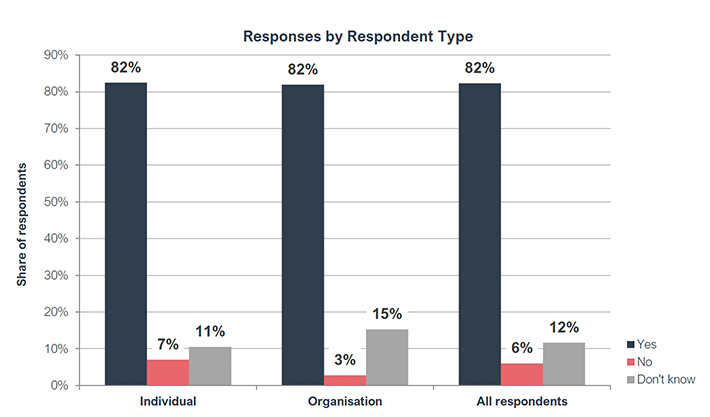Violence against women and girls funding review: analysis of responses
Analysis of the responses to the Strategic Review of Funding and Commissioning of Violence Against Women and Girls Services call for evidence.
Questions 9.1 and 9.2
Should services and providers for women, children and young people experiencing violence against women and girls be based on need in their local area? Please give reasons for your answer.
71% of the respondents believed that services and providers for women, children and young people experiencing VAWG should be based on local area needs. Agreement rates were higher among organisations (81%) than among individuals (67%).

The free-text part of this question comprised 172 responses, consisting of 105 responses by individuals and 67 by organisations. The organisations that answered this question included 7 local authorities/governments, 4 NHS organisations, 38 third sector organisations, and 18 classified as "other" or did not specify.
The section below presents the most frequent themes emerging from the qualitative in order of how frequently were brought up by respondents to the question. These themes were predominantly mentioned by respondents who believed that services and providers for women, children and young people experiencing VAWG should be based on need in their local area.
Theme 1: Regional and temporal differences
The most common theme was that providers and services for victims of VAWG should be based on need in their local area because this would account for regional and temporal differences. Specifically, respondents believed that there are differences across regions in terms of demographics, socio-economic characteristics, and incidence of VAWG, thus each region should have services tailored to its needs. Some respondents highlighted that regional needs also vary over years within the same area, so a frequent assessment of needs would ensure the right level and type of provision.
"Yes, funding should be provided and based on demand for the service in the local area and statistics in that area, it should not be a postcode lottery, the size of the services will vary across Scotland and should be looked at for each local authority individually based on the evidence from Police/MARAC/Women's Aid etc." (Individual)
Theme 2: Minimum level of provision
The second most frequently mentioned theme was the need for at least a minimum level of VAWG provision across all regions. Respondents indicated that, regardless of the level of needs in the local area, there should be a national standard of minimum provision, ensuring a basic coverage of needs. Nevertheless, some respondents indicated that while every area should meet the minimum level of provision, there should also be scope to account for regional differences.
"Whilst a national minimum would help to create a baseline, third sector and other partners can respond to complex themes within an area - for example, prevalence of trafficking may be linked to some areas more than others hence a local response should be sought." (Third sector organisation)
"There should be consistent services, providing an agreed minimum level of provision, but with the flexibility to amend provision and means of delivery to reflect local need." (Third sector organisation)
Theme 3: Challenges in assessing local needs
The third most common theme was concern about the challenges in assessing local needs since reporting rates vary across local authorities and not necessarily reflect the real number of cases. Conversely, low reporting rates could be correlated with a lack of awareness and support rather than a lower crime rate. Some answers indicated that the level of local needs could be accurately estimated by local providers offering services near the communities, thus local provision was believed to be essential in collecting the data needed to assess whether local provision is required.
"Nevertheless it is challenging to determine what local need is when it comes to VAWG - in some areas of Scotland there will be less understanding of VAWG and therefore potentially less reporting of it. It might therefore be thought that fewer services were required, when in fact even more resource is required to both raise awareness and provide support." (Public sector/ Higher and further education)
Theme 4: Accessibility
The next most common theme was the importance of access to VAWG services. Responses stated that provision of VAWG services should be based on local needs and placed as close to the community as possible, in order to facilitate access. This was believed to be especially important in rural areas, where women and girls experiencing VAWG might need to travel considerable distances to find appropriate support.
"These services must be available locally, perhaps using GP premises. Currently the more rural you are the less access to these services you have." (Individual)
Theme 5: Equal provision
The last prevalent theme was the need for equal provision. In particular, some respondents believed that there should be an international level of VAWG provision regardless of the characteristics of each area. This suggestion was often associated with fairness and consistency, as respondents believed that all victims should have equal access to services of similar quality, instead of these being dependent on where they happened to live.
"All women and girls should have equal access to services but at present these only exist in highly populated areas such as large towns or cities. Rural areas also need adequate access to services and provision and women deserve more than a post code lottery response." (Individual)
Contact
Email: Jane.McAteer@gov.scot
There is a problem
Thanks for your feedback